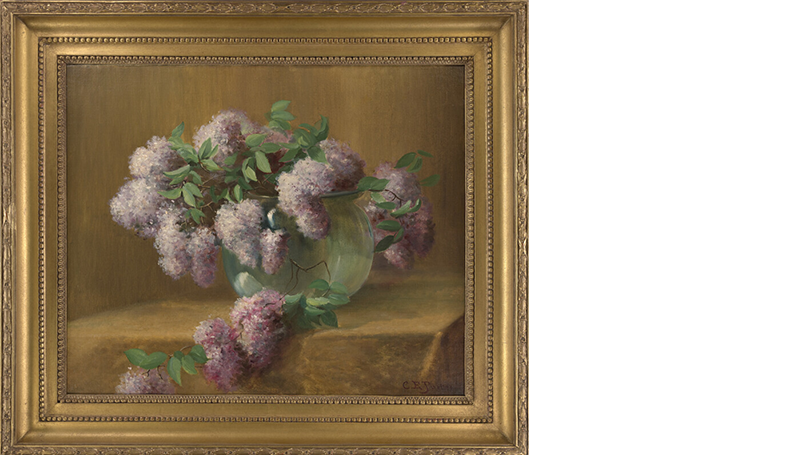
LEFT Charles Ethan Porter, Lilacs, about 1885–1890, oil on canvas, 19 1/8 × 23 1/8 in. Hood Museum of Art, Dartmouth: Purchased through the Robert J. Strasenburgh II 1942 Fund; 2024.10.
MICHAEL HARTMAN, Jonathan Little Cohen Associate Curator of American Art
Charles Ethan Porter was a Black artist from Connecticut best known for his still life paintings. Growing up in a working-class household, he first studied painting in 1868 with Ada E. Philbrook and Rosa P. Merrill at the Wesleyan Academy in Wilbraham, Massachusetts. Porter later enrolled at the National Academy of Design in New York City, likely becoming the first Black artist admitted to their classes.
Porter returned to Connecticut and established a studio in Hartford, where his work was celebrated by local arts patrons and covered in newspapers. Porter later stated that he encountered less racism and resistance to his work as an African American artist while working in Connecticut rather than New York City. Even after his artwork fell out of fashion early in the 20th century, Porter nurtured many young artists, both White and Black, throughout his career.
In 1881, Porter traveled to France, where he studied at the Petit École des Beaux-Arts and Académie Julian, likely working under William Bouguereau, Gustave Boulanger, Jules Lefebvre, and Tony Robert Fleury. While in France, Porter lived at 13, rue des Beaux-Arts, just steps away from noted French flower painter Henri Fantin-Latour at number 8. From Fantin-Latour, Porter likely learned how to achieve greater realism by using looser brushwork and painting flowers with a softer palette set against lighter backgrounds to offset the colorful blooms. Porter would have also seen similar characteristics in the still lifes of Edouard Manet and other French impressionists.
Painted shortly after returning from France, Lilacs testifies to Porter's French studies. Daubs of white paint lift off the flowers set against a thinly painted background, emphasizing the flowers' three-dimensionality. The table's orthogonal parallels the positioning of the flowers draped across it, revealing Porter's academic training through his mathematical balancing of the composition. In the strong side-lighting, shadows bounce off the petals to give a greater sense of visual interest.
Porter's Lilacs also reveals an early attraction to abstracted forms that would become more common among 20th-century artists over time. Looking closely at the flowers, broad swaths of color beneath the petals transform into the white and violet blossoms. His leaves are likewise composed from larger brushstrokes in vibrant colors, giving more of an impression than a scientifically accurate representation of his subject.
This is the second work by Porter to enter the Hood Museum's collection—the first being a watercolor of flowers and butterflies—and it reflects a dedicated effort to collect works by African American artists, especially those working in the 19th century. This effort also includes the recent purchase of an 1898 landscape painting by James Bolivar Needham, now on view in Liquidity: Art, Commodities, and Water.
Click here to view this object's catalogue entry.